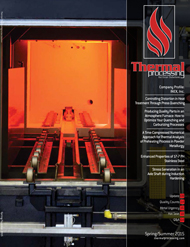Induction hardening is the most common technique of the various types of applied energy processing. It uses alternating current that induces a magnetic field in a workpiece causing the workpiece to heat up to a certain depth below the surface. The piece is then quenched, which results in an increase in hardness within the heated area. The process is typically completed in a relatively short time. Final desired workpiece performance characteristics are determined by the hardness profile and induced stresses, which are influenced by the steel grade (chemical composition) and prior microstructure of the starting material.
The case hardness pattern produced by induction heating (%%0415_MU_1%%) is a function of the inductor type and shape, as well as the heating method. Quenching or rapidly cooling the workpiece is accomplished by spray and submerged quenching, typically using water or a water-based polymer. Quench severity is controlled by the polymer concentration. Cooling rates are usually somewhere between those obtained with pure water and oil. In some special cases, compressed air is used to quench the workpiece. Some applications require through hardening where the entire piece is hardened and tempered.
Material Selection
Plain carbon steels are classified into four distinct series in accordance with the AISI system:
- The 1000 series are plain-carbon steels containing no more than 1.00% manganese
- The 1100 series are resulfurized (sulfur is added) carbon steels for machinability
- The 1200 series are resulfurized and rephosphorized for machinability
- The 1500 series have between 1.00 and 1.65% manganese
Carbon is the key to the hardening of steels. The carbon level of steel determines the maximum obtainable hardness (%%0415_MU_2%%). The lower the carbon level, the lower the maximum as-quenched hardness that is achievable.
Steel grades commonly induction-hardened include 1045, 1050, 1144, 4140, 4150, 4350, 5150, and 8650. Some of these grades are cold drawn using very high reductions, which produce high tensile and yield strengths. Alloy steels require a quenched and tempered prior microstructure to optimize hardness and reduce the case-transition zone. Higher carbon content makes machining more difficult. Therefore, 1141 and 1144 grades are used where hardenability as well as ease of machinability is required. These steels are resulfurized, where the formation of sulfide inclusions significantly increase machinability.
A rule of thumb in steel grade selection is to select the grade with a carbon content that will produce the required hardness and mechanical properties for the application. For example, if a hardness of 40 HRC is needed, carbon content can be below 0.30%. However, if the required hardness is 60+ HRC, a carbon content greater than 0.50% is required. The use of lower carbon increases ductility and reduces the chances of quench cracking.
Induction hardened plain carbon steels have shallower case depths, and alloy steels can be hardened to higher hardness at greater case depths. The addition of a small amount of boron (0.001%) to low and medium carbon steels results in an increase in hardenability (%%0415_MU_3%%). Charts showing different alloys and the relationship of hardness, machinability, and ease of grinding are available in the literature, and is an easy way to evaluate the manufacturing process. Steel suppliers have steel grade price charts with product forms available.
References
- D.H. Herring, F.J. Otto, and F.R. Specht, Gear Materials and Their Heat Treatment, Industrial Heating, September, 2012.
- R.E. Haimbaugh, Practical Induction Heat Treating, ASM International, 2001.
- Properties and Selection: Irons, Steels, and High-performance Alloys, Vol 1, ASM Handbook, ASM International, 1990.



































